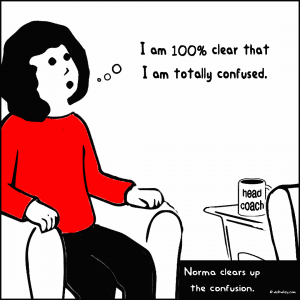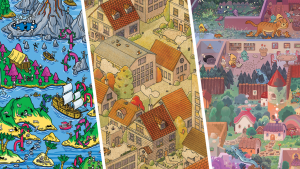
The large timer on the wall reads 01:45 as I briefly glance up from a board full of lights and buttons. This light board is presumably the last puzzle that, when solved, will complete an hour-long immersive puzzle marathon, otherwise known as an escape room. Each button flips a number of lights from one state to the other (on/off). Some lights can be controlled by multiple buttons. The goal of the puzzle is to turn off all the lights on the board. I know there’s a logical way to approach this puzzle, but with time quickly dwindling to zero, I hurriedly press buttons in random combinations. As luck would have it, I stumble upon a darkened board with 00:30 remaining, but the door doesn’t open. My teammates and I run around the room checking for any incomplete puzzles but find nothing. 00:00 glares in bright red on the wall and feelings of confusion and disappointment wash over us. The gamemaster opens the door and sheepishly says, “you guys did solve the final puzzle, but we had a technical malfunction. So yeah, congratulations – final time 59:30”, and ushers us out of the room. As we head back to our cars, I feel deeply unsatisfied. We won, but why do I feel like we didn’t?
—–
The editor of the New York Times’ crossword puzzle holds the world’s only college degree in enigmatology, or the study of puzzles. My recent unsatisfying escape room experience got me thinking, how are puzzles made, and how do you make a good puzzle? There are, of course, all kinds of puzzles, such as crossword, jigsaw, verbal riddles, and entire puzzle video games. And crucial elements for a well-designed puzzle can change depending on the puzzle medium. However, I’ve gathered that there are a few commonalities that most good puzzles share.
First, the goal of the puzzle is clear. The player isn’t trying to figure out what to do, just how to do it. The goal of a jigsaw puzzle, for example, is to fit all the puzzle pieces together such that they form a represented image. A clear goal is necessary to initiate logical thinking; otherwise, problem solving gives way to pure confusion.
Second, the mechanics or rules of the puzzle are clearly explained. For well-known puzzles like jigsaws, mechanics may seem like second nature. But at one point, someone had to explain to you that each piece is designed to perfectly fit together with a set number of other pieces, and that you can use coloring on each piece to infer which ones fit together. Well-defined mechanics are usually more important in riddles or puzzle games, where the puzzles can exist in a fictitious world.
Third, a good puzzle is well-presented. In other words, there are as few extraneous elements as possible. The puzzle is presented so minimally that it becomes inviting and those that encounter it want to solve it. Simple presentation can also help the player find a starting point to explore the puzzle and prevent them from feeling overwhelmed. Personally, I feel that puzzles containing misleading elements purely to mislead can not only be frustrating, but also are a dead giveaway for a poorly designed puzzle (For example, extra pieces in a jigsaw that don’t fit).
Fourth, the puzzle has a catch that makes the goal seem initially unachievable with the given mechanics. In the case of a jigsaw, the catch is less “unachievable” and more “extremely tedious”, but regardless, the catch allows the player to identify a problem and immediately not know how to solve it. Stumping the player, at least for a non-excessive amount of time, sets them up for a satisfying end when they do solve the puzzle. For example, consider the clue, “covered in chocolate” from a NYT crossword. Immediately, we may think “strawberry” or “pretzel”. But those words don’t work with the rest of the puzzle, so what could it be?
Fifth, the solution requires a logical but new application of the mechanics that gives players an “aha!” moment. It allows them to make a discovery and feel smart. The answer to the NYT crossword clue, for example, is “Labrador”. To arrive at the solution, a player must think of alternate meanings for the clue, thus applying the mechanics in another way. This element, in my opinion, is the trickiest part of puzzle design, as a good solution must be non-obvious but still reasonable. If a solution is too obscure, a player can feel that the mechanics weren’t fully explained; if it is too obvious, the puzzle can just feel like busywork.
All these elements work together to create an immersive experience that give players a feeling of accomplishment when they complete a puzzle. With this in mind, I now understand why my escape room felt so unsatisfying. First, a couple puzzles in that room didn’t have a clear catch, so the payoff for those felt minimal. Second, there were several decoy items and props that had no ultimate use. Third, I spent a significant amount of time trying to find the last piece to a jigsaw puzzle, and those who have ever completed a jigsaw puzzle know how frustrating that can be. And finally, I was robbed of my “aha!” moment. Given the time constraints, I didn’t approach the last puzzle in a logical way, so I never identified the catch of puzzle and didn’t experience a revelatory moment when the lightboard turned dark. On top of that, the puzzle malfunctioned, so my team never got to experience the satisfaction of hearing the click of the door unlock and rushing out of the room with seconds to spare. Instead we remained, trapped, confused and disappointed.
By no means am I discouraged from escape rooms or puzzle solving at large. If anything, I appreciate how much work goes into creating puzzles, and how designing a good puzzle is a puzzle in itself. Certain puzzle makers, like those who edit the NYT crossword, make puzzles that are played by millions of people every day; that’s an awesome responsibility! And though the field of enigmatology is relatively new (coined in 1974), humans have been creating puzzles for thousands of years. What does that say about our minds, or about human nature? How do the puzzles we play influence thought patterns and thinking processes? I’m curious to see what future enigmatologists uncover.
—–
P.S. If, after reading this, you have an itch to try some puzzles yourself, here are a few that I personally think are well-designed:

- For jigsaws, try a puzzle from the Magic Puzzle Company ($20 each on Amazon). These puzzles were designed in collaboration with magicians and have an added twist at the end that makes for a bigger “aha!” moment. Even if they didn’t have that though, the puzzles showcase original, incredibly detailed, colorful, imaginative artwork and it’s a joy to look at each piece.
- For a relaxing, incredibly aesthetic mobile puzzle game, try Monument Valley. In it, you manipulate the environment to guide a character through a series of platform mazes. It’s flush with optical illusions and colorful geometries that are super pleasing to look at. I have bought artwork from it.
- For an impressively simple puzzle game, try Baba is You. In this game, the mechanics are presented as physical objects that you can move around. By moving and changing the mechanics, you change how the game works. A pretty unique experience.
Peer edited by Connor LaMontagne